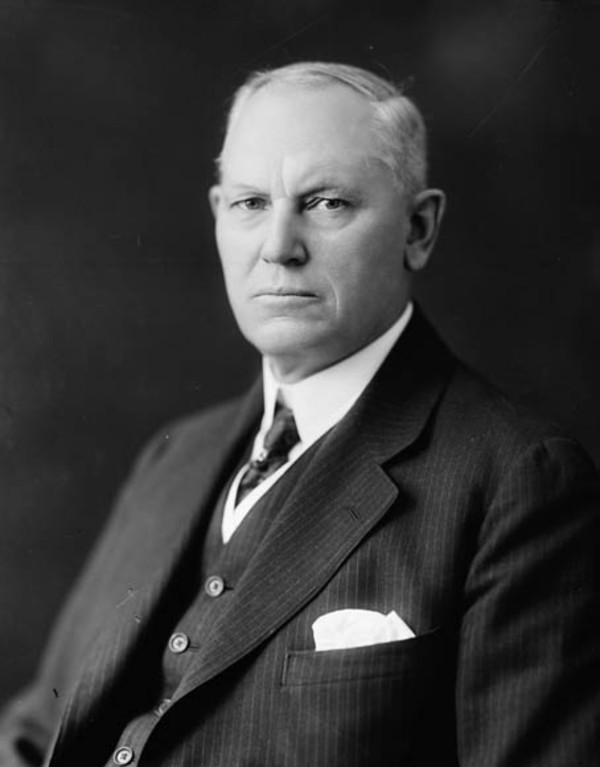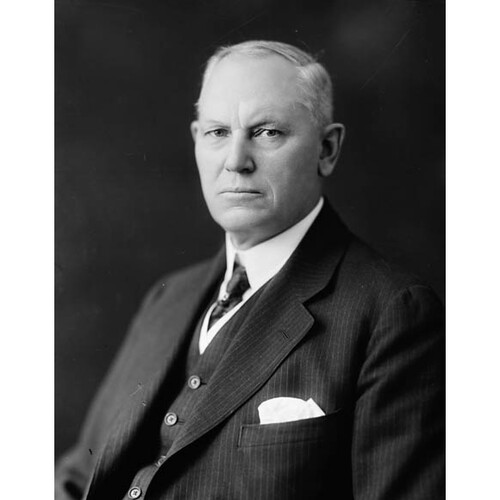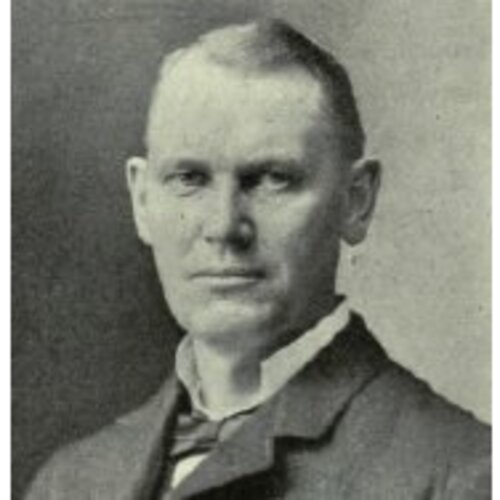CARVELL, FRANK BROADSTREET, lawyer, businessman, and politician; b. 14 Aug. 1862 in Bloomfield, N.B., son of A. Bishop Carvell and Margaret Lindsay; m. 28 July 1887 Caroline B. Parks in Lakeville, N.B., and they had a daughter; d. 9 Aug. 1924 in Woodstock, N.B.
Frank Carvell was born in the village of Bloomfield, about a mile from the Maine border and twenty miles from Woodstock. His father was a farmer descended from loyalist stock; his mother was of Ulster Irish background. The family, which included altogether four boys and two girls, were devout Wesleyan Methodists and Frank attended church regularly throughout his life.
Carvell was educated in the public schools of Bloomfield and Woodstock and then taught school for a time, obtaining a first-class teacher’s licence in December 1884. Two years after his marriage to Carrie Parks in 1887, he enrolled in Boston University. He was awarded the llb degree with honours in 1890 and returned to Woodstock to practise law with Lewis Peter Fisher. Quickly successful, he earned a reputation as a powerful advocate and formidable prosecutor. He was elected to the Carleton County Council and became a well-known businessman who held considerable stock in the Woodstock Power Company and the Carleton Electric Company. He was also a director of the New Brunswick Telephone Company Limited. In due course he purchased the Carleton Sentinel, a vigorous voice for Liberalism in the province, and he was for a time a principal shareholder in the Carleton Observer as well. For several years he served in the 10th (Woodstock) Field Battery of the Canadian militia, retiring as a major in 1906. The following year he was gazetted a kc.
In 1899 Carvell had successfully contested the Carleton seat in the provincial election as a Liberal candidate. He resigned in the fall of 1900 to run for Carleton in the Canadian House of Commons and lost by 255 votes to the incumbent Conservative lumber merchant from Woodstock, Frederick Harding Hale. Carleton County had a population of just over 21,000 in 1901, and Woodstock, Carvell’s home base, 3,644. A great majority in the county earned their livelihood from the land. Sturdy, hard-working rural people, practically all of whom had been born within the province, they were English-speaking and Protestant and many harboured a strong anti–Roman Catholic bias. Both locally and federally Carleton was long regarded as a Conservative stronghold. Carvell challenged the dominant religious and political sentiments of the county. In New Brunswick politics, where he was deeply engaged during his Ottawa years, he strongly championed a tight alliance between Roman Catholic Liberals, who dominated the northern half of the province, and Protestant Liberals in the south. In national politics he took the seat as a Liberal in 1904, when he had a majority of 274, and again in 1908 and 1911. In 1917, in the conscription election, Carvell would win the Victoria and Carleton seat as a Unionist (conscriptionist Liberal) by acclamation.
Until the government of Sir Wilfrid Laurier* was defeated in 1911, Carvell was a minor figure in Liberal affairs in Ottawa. Henry Robert Emmerson*, minister of railways and canals, was New Brunswick’s spokesman in the party until he was forced to resign over a personal scandal in 1907. Carvell’s friends then launched a campaign urging his appointment to the cabinet. But Laurier had other petitioners too. “Every mail brings me a batch of letters, divided into two sets of opinion; one set for [William Pugsley] and the other for Carvell. The longer this is allowed to remain the worse it must be.” Pugsley, who had been a senior member in the Liberal New Brunswick government since 1900 and was briefly premier in 1907, won out. Laurier appointed him minister of public works at the end of August. Two years later, in May, Pugsley was promoting Carvell to Laurier for an appointment to the Supreme Court of New Brunswick. Laurier was not enthusiastic and himself asked Carvell to stay in the House of Commons. Against his wife Carrie’s wishes, Carvell agreed, telling Laurier that he had “decided to remain as requested.”
After 1911, in opposition, Carvell acquired the prominence that had so long eluded him as a government backbencher. His sharp tongue and belligerent speaking style made him one of the most persistent and damning critics of Robert Laird Borden*’s government. A favourite target was the minister of militia and defence, Samuel Hughes. Carvell was convinced that Hughes was extravagantly wasting the public’s money. In the committee on supply in March 1912 he went after Hughes at every turn. The minister, he said, “talks about defending our homes, our wives, sisters and sweethearts, and all that tommyrot. He knows there is no danger of invasion. . . . The great trouble with my hon. friend and with his general staff is that they spend too much money on fuss and feathers and gold lace and not enough to teach young men how to shoot.” Just days later Carvell turned his attention to Alfred Bishop Morine*, a former minister of finance and receiver of customs in Newfoundland. Borden had recently appointed him head of a commission to make recommendations on improving and reforming the public service. Carvell charged that Morine, while Newfoundland’s finance minister, had also been on retainer as solicitor for Robert Gillespie Reid*, a railway contractor who had extensive dealings with the Newfoundland government. Morine quickly replied in the press that he had indeed been a legal adviser to Reid and “openly acted in that capacity,” adding that other counsel for Reid had sat in a previous Newfoundland government. Borden, taken completely by surprise, announced that Carvell’s allegations were of an “exceedingly grave character.” Morine dispatched long memoranda to the prime minister, each more desperate than the last, seeking to refute Carvell’s allegations. But within days he was gone, resigned, leaving Borden’s prized Public Service Commission besmirched and Carvell with a new nickname: “Lord High Executioner.”
Using the same combative tactics, Carvell joined New Brunswick Liberal organizers Edward S. Carter and Peter John Veniot* in forming the “Dark Lantern Brigade” to crusade against James Kidd Flemming’s Conservative government. Flemming, who represented Carleton in the provincial house, was Carvell’s “personal adversary.” In March 1914 Carvell, in Ottawa, charged that a member of Flemming’s caucus and promoter of the tiny Southhampton Railway in New Brunswick, James K. Pinder, had illegally received federal subsidies for building the road. A commission in July confirmed the charges. Meanwhile, backed by Carvell, Louis-Auguste Dugal, one of two Liberal members in the New Brunswick house, in April charged that Premier Flemming was involved in kickbacks to his party in the renewal of timber licences and in similar kickbacks from the contractors for the Saint John Valley Railway. A provincial royal commission, chaired by judge Harrison Andrew McKeown*, was appointed to investigate the charges and Carvell served as lead counsel for Dugal. Made public in November, the commission’s report exonerated Flemming on the charge that he had directed the kickback scheme for timber licence renewals but found that he had compelled a railway contractor to make a contribution to the party. The following month Flemming resigned from office and his seat in the legislature.
In parliament Carvell continued to snipe at the perceived follies and misdeeds of the Borden government. In 1915 John Dowsley Reid, the minister of customs, “my sanctimonious friend,” “a gentleman who could not do a political wrong if he wished, a gentleman who never employed an official excepting under the greatest of necessity,” was accused of wasting precious public funds in wartime. William Thomas White*, the respected minister of finance who had raised tariffs to meet the increased expenditures of the war, was another target. Carvell was suspicious. The tariff increases, he insinuated, had less to do with war necessities than with paying for the spendthrift habits of Reid, Hughes, and their cronies on the government benches. “This country is at war,” he lectured, and “the Government . . . have no right to tax the people white in order to satisfy and placate their political friends over the country.” The following year Carvell was at the front of the opposition attack on corruption in the Shell Committee scandal. He accused the government of trying to “cover up their tracks and whitewash and cleanse the character of the Minister of Militia and Defence” while they “refused investigations of things which any reasonable intelligent man knows are so dishonest that they would stink in the nostrils of every man in Canada.”
Now, when he had become a prominent party figure, the New Brunswick Liberals desperately wanted Carvell to come home and lead the listless and ineffective provincial party. Laurier would have none of it. “Carvell is too good a man to let go,” he wrote. “I know he would be a tower of strength to our friends in New Brunswick, but we have the tower in Ottawa and must keep him.”
In 1917, in the darkest days of the war, Carvell reached a decisive turning point in his political career. A long-time foe of the “curse of public ownership,” he was adamantly opposed to the government takeover of the Canadian Northern Railway [see Sir William Mackenzie]. And he was disgusted by the blatant political jobbery inherent in the War-time Elections Bill. As he told Laurier, “The Government are disfranchising Austrians, Germans, British subjects; they are disfranchising women; in fact, it seems to me that they are disfranchising anyone who they think will vote Liberal.” Conscription was another matter and here Carvell dramatically broke with his leader and his party. “I look upon it as our duty to send all the men that we possibly can, in order to make this war the success that the whole civilized world is praying that it will be.” He categorically dismissed any notion that, as the Liberal party proposed, a referendum be held before conscription was implemented. “There is not a stronger democrat in Canada than I am; there is no man who, under ordinary conditions, has greater faith in the people than I have. But I am constrained to come to the conclusion that we are at war, and this is not an ordinary political matter; it is a question of life or death for civilization.”
As the Liberal party quarrelled and split over the issue, Borden approached Carvell about crossing the floor. Carvell refused. In late September 1917 he helped Laurier with a plan for what Laurier would do about conscription if he won the forthcoming election. Then, suddenly, Conservatives were awash in rumours that Laurier was going to resign and that Carvell would become the new leader of the Liberal party and join the Union government. New Brunswick Tories were appalled. They told Borden that Carvell would join the Union government only to “wreck it,” that he could not command the support of Conservatives in his own constituency, and that the move would be “suicidal” for the party in the province. For his part, Laurier did not resign, but Carvell did join the Union government as minister of public works on 13 October. Borden told a New Brunswick Tory that “Carvell has been altogether too bitter in his political warfare” but “now that he has come in he comes in whole-heartedly.” Laurier confessed that “Carvell is more and more an enigma for me.”
Carvell had joined for the duration of the war. It was a difficult role for him and for his colleagues. His talent as a destructive critic had to be reined in for the responsibilities of governing. Several victims of his slashing attacks now sat with him in cabinet. He did not like them and they did not like him. Still, there was a job to do. He was chairman of the committee overseeing the construction of the new centre block of the Parliament Buildings following the disastrous fire of 1916. Just before the conscription election in December 1917, he and his old foe J. D. Reid were dispatched to Halifax to organize and supervise relief efforts after the Halifax explosion. Though in office, he remained an adamant opponent of government ownership and operation of railways, telling a Montreal audience in February 1918 that “Government operation of railways has been one of the most tragic failures this country has ever seen.” As soon as the war was over he announced his opposition to the business profits tax, initiated in 1916 but an “improper” measure in peacetime. Yet he firmly believed in extending the scope of the income tax, arguing that the tax on higher incomes should be increased and that every person earning one thousand dollars should pay “not a very big tax, but enough to cause him to realize that he is helping to pay the taxes of this country.” In his own department he took pride in cutting expenditures by 2 million dollars in fiscal 1917–18 and another 1.5 million in 1918–19. In the spring of 1919, however, with the war over and rising unrest in Canada, he defended increased expenditure on public works in major cities to keep people employed. This, he told the commons during the debate on the speech from the throne, would ensure that “we shall have no Bolshevism or anarchism and many of our difficulties will be solved.” Then, almost as suddenly as he had entered the government, Carvell, in August 1919, announced his resignation.
Carvell was willing to rejoin the Liberals but they would not have him. As the Saint John Telegraph Journal later remarked, he had “burned his bridges behind him” in 1917. Instead, Borden offered and he accepted the chairmanship of the Board of Railway Commissioners. There, in a quasi-judicial position, regulating the railways, telegraphs, and telephones, Carvell and his fellow commissioners were responsible for the investigation of railway accidents (there were 2,093 in 1920 with 254 persons killed and 2,330 injured), authorizing the placement of railway stations and the level of service they would provide, and approving freight tariffs and telephone and telegraph rates. Most of the nearly 4,000 applications the board received annually were routine and handled by the staff. But the commissioners conducted investigations and public hearings and rendered written judgements in major cases. Here Carvell’s legal training in Boston decades before came to the forefront in his carefully crafted decisions on complex issues.
It was a long way from the excitement and challenge of blistering attacks in opposition, even from the brief flirtation with power in the cabinet. Nevertheless, the appointment kept Carvell involved in public life while allowing him ample opportunity to return home to Woodstock on weekends to his family and his beloved farm on the outskirts of town, where he had four hundred head of purebred cattle. That was Carvell’s routine in the early 1920s. Then, on a hot and humid Saturday, 9 Aug. 1924, just before dusk, he died. He had arrived from Ottawa in mid afternoon, gone to the farm, and walked to the far end of the property where his farmhands found him, dead of a stroke. Predeceased by his daughter, he was survived by his wife, one brother, and his two sisters.
Carvell had been a stern, combative man in public life, a man who took pleasure in punishing, withering criticism of his enemies. For all but a few he was aloof from supporters and colleagues and feared by his opponents. In his family life he was a sympathetic, loving, and generous husband and father, and he was passionately interested in his farm and cattle. Neither in public nor in private did he lose his serious demeanour. He seemed, even to friends, devoid of a strong sense of humour and the enjoyment of life. As his own newspaper, the Carleton Sentinel, observed, Frank Carvell “did not know how to play.”
The main collections of manuscripts documenting Carvell’s career are held at the NA: Sir Robert Laird Borden papers (MG 26, H), Sir George Eulas Foster papers (MG 27, II, D7), Sir Edward Kemp papers (MG 27, II, D9), Sir Wilfrid Laurier papers (MG 26, G), and Arthur Meighen papers (MG 26, I). Useful newspapers are the Carleton Sentinel (Woodstock, N.B.), Gazette (Montreal), Globe (Toronto), Halifax Herald, Morning Chronicle (Halifax), Ottawa Citizen, Ottawa Evening Journal, Telegraph-Journal (Saint John), and Woodstock Press.
R. C. Brown, Robert Laird Borden: a biography (2v., Toronto, 1975–80). R. C. Brown and Ramsay Cook, Canada, 1896–1921: a nation transformed (Toronto, 1974). Can., Census and Statistics Office, Canada year book (Ottawa), 1913; Dominion Bureau of Statistics, Canada year book (Ottawa), 1922/23; House of Commons, Debates, 1904–19; Parl., Sessional papers, report of the Board of Railway Commissioners, 1920–24; report of the minister of public works, 1918–19. Canadian annual rev., 1901–24/25. A. T. Doyle, Front benches & back rooms: a story of corruption, muckraking, raw partisanship and intrigue in New Brunswick (Toronto, 1976). H. G. Thorburn, Politics in New Brunswick (Toronto, 1961)
Cite This Article
Robert Craig Brown, “CARVELL, FRANK BROADSTREET,” in Dictionary of Canadian Biography, vol. 15, University of Toronto/Université Laval, 2003–, accessed April 2, 2025, https://www.biographi.ca/en/bio/carvell_frank_broadstreet_15E.html.
The citation above shows the format for footnotes and endnotes according to the Chicago manual of style (16th edition). Information to be used in other citation formats:
| Permalink: | https://www.biographi.ca/en/bio/carvell_frank_broadstreet_15E.html |
| Author of Article: | Robert Craig Brown |
| Title of Article: | CARVELL, FRANK BROADSTREET |
| Publication Name: | Dictionary of Canadian Biography, vol. 15 |
| Publisher: | University of Toronto/Université Laval |
| Year of revision: | 2005 |
| Access Date: | April 2, 2025 |





